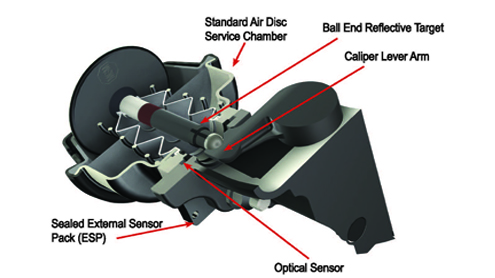

Electronic monitoring addresses the CVSA inspection standard
By Chad Robinson
The current reality of reduced maintenance staffing and declining budgets begs for greater effectiveness in every operational area. Electronic brake monitoring as a proactive approach to maintenance has increased in popularity as the technology has developed. This technology enables operators to reduce costs by identifying trends that lead to problematic brake issues. Left undetected, a minor issue can prematurely mushroom into serious component damage and compromise the safe operation of a vehicle.
MGM Brakes, Charlotte, NC, a 50-year-old supplier of air brake actuators worldwide, became interested in electronic brake monitoring with its development of the e-Stroke Brake Monitoring System for S-Cam (drum) brakes. The company designed this system to address the CVSA standard that requires the driver to conduct a walk-around brake inspection of all vehicles equipped with air brakes before each daily service.
The brake actuator in both S-Cam (drum) and air disc systems is the conversion point where pneumatic energy is converted to mechanical force, and where problems with air delivery, air release, and mechanical problems that effect brake adjustment and stroke, can be readily detected.
Integrating electronic brake monitoring into the brake actuator was the ideal location to achieve this goal.
MGM Brakes has continued development of the e-Stroke brake monitoring system with ES3D for air disc brakes. MGM’s prior ES3 technology utilized an Electronic Controller (ECU) and Hall Effect Sensing Technology to monitor brake stroke, which is still widely deployed on S-Cam (drum brake) applications.
The new ES3D technology utilizes the same ECU, cabling, diagnostic software, and now adds new infrared optical sensing technology to monitor air disc brake operation. The new spring-loaded chamber ball-end design monitors proper contact and movement of the caliper lever arm during each application and release of the brakes.
The first system designs were simple LED-lit stroke indicators that indicated proper brake function and stroke compliance. Today’s systems fully integrate with the vehicle J-1939 data bus, displaying, sending and recording assigned SAE fault codes for out-of-adjustment, dragging, and faulty or non-functioning brakes.
The ES3D system monitors the vehicle braking system in real-time and can detect:
-Non-functioning brakes caused by broken air hoses, faulty valves and faulty brake chambers
-Dragging brakes caused by faulty valves, faulty parking chambers and caliper adjuster failures
-Over stroke brakes caused by caliper adjuster mechanism failure or other mechanical failure
MGM’s E-Stroke Gen 3 S-Cam systems have been widely adopted for use in transit and passenger bus applications. The operational demands for continuous service, longer duty cycles and proactive maintenance have made electronic brake monitoring popular. This is due largely to its ability to accurately define problems early and relay those via AVM systems, as well as via the onboard diagnostics available to maintenance personnel.
Air disc brake systems pose an even greater challenge to maintenance and periodic inspections due to the lack of brake component accessibility.
A recent gathering of CVSA and industry experts resulted in an agreement that the only physical inspection of disc brakes a technician could perform required removal of the wheels to check pad wear. Running the vehicle over a pit or putting it on the lift to check brake function would prove fruitless unless the rotors showed obvious rust or were visibly scored from metal-to-metal contact with worn-out brake pads.
Other potential avenues to ensure functionality include placing the vehicle on a rolling dynamometer to check parking brakes and service brake forces, or using a temperature-sensing device on wheels after repeated service applications to check wheel end temperatures.
At MGM Brakes we believe onboard technology, like the ES3D brake monitoring system, is the most cost effective and reliable solution. This technology provides real-time diagnostics that monitor brake conditions with every brake application.
As a safety device on tour buses departing from remote locations, or as a maintenance alert for city transit operators, real-time monitoring of air disc brakes equates to safer vehicles and better component utilization. It’s like having an inspector on board. Whether the system is alerting the driver via vehicle displays or alerting maintenance to persistent faults in the air brake system, ES3D users will find that having a constantly watchful eye on their braking system will ensure better operational returns and safer braking performance.BR
Chad Robinson is the market development manager, Global Transit and Bus, at MGM Brakes.
